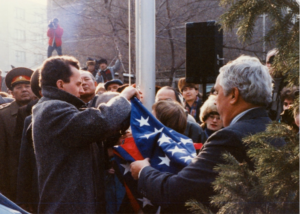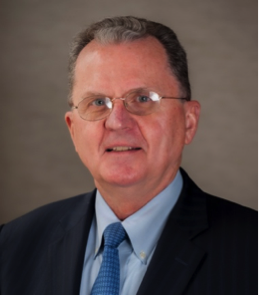by Jackson McDonald
Thirty years ago, on December 25, 1991, President Mikhail Gorbachev resigned, and the Soviet Union split into Russia and fourteen newly independent republics. U.S. Secretary of State James Baker ordered the opening of American embassies in six of the new republics before the end of January 1992 and the remainder by mid-March.
Serving as a mid-level Foreign Service Officer at the U.S. embassy in Moscow, I volunteered to lead the team that opened our embassy in Alma-Ata (later renamed Almaty), the capital of the newly independent Republic of Kazakhstan.
At the end of January 1992, just in time to meet Secretary Baker’s deadline, six of us departed Moscow’s Domodedovo domestic airport for the five-hour Aeroflot flight to Alma-Ata. In the last days of the Soviet Union, prices made no sense; each airline ticket cost $2.17. We carried an Inmarsat satellite phone the size of a large suitcase, office supplies, personal baggage, and a diplomatic note from the Department of State to the Ministry of Foreign Affairs formally establishing the U.S. Embassy to the Republic of Kazakhstan.

The United States was the first country to recognize independent Kazakhstan and the first to establish an embassy there. We were quickly followed by Iran, Pakistan, and Germany, and later by Turkey, France, the U.K., China, North Korea, Russia, the European Union, and others.
Unexpected Independence
Unlike many republics of the Soviet Union, the Kazakh S.S.R. had never clamored for independence from Moscow. When the Soviet Union crumbled, the government and people of Kazakhstan nevertheless found themselves faced with the task of establishing new political, economic, and security structures suitable for a sovereign, independent member-state of the international community.
Building on the existing power structure, First Secretary of the Communist Party Nursultan Nazarbayev became President of the Republic. Other government institutions continued to function much as before, but without receiving orders from Moscow. The government of Kazakhstan approached these fundamental transformations methodically, and the people confronted this period of change and uncertainty with stoic resolve.
Over the next two years, Kazakhstan adopted a new constitution, a flag, and a national anthem. It issued its own national passport and its own currency, the tenge, to replace the Soviet ruble. It introduced Kazakh as the official language but recognized Russian as a language of interethnic communication.
Strategic Importance to U.S.
What made Kazakhstan special, however, was its strategic importance to U.S. security interests in the post-Soviet space. Along with Russia, Ukraine, and Belarus, Kazakhstan was one of four successor states to a series of bilateral and multilateral arms control agreements concluded with the former Soviet Union.
Having endured decades of Soviet above-ground nuclear testing – with devastating health consequences for the indigenous population – Kazakhstan’s leadership made the crucial decision to declare the country a non-nuclear state and to facilitate the removal of all Soviet-era nuclear weapons from its territory.
Kazakhstan adhered to the multilateral Nuclear Non-Proliferation Treaty (NPT) as a non-nuclear power. It ratified the Strategic Arms Reduction Treaty (START) negotiated between the U.S. and the Soviet Union to limit long-range nuclear weapons. It joined the Conventional Armed Forces in Europe Treaty (CFE). Although situated in the heart of Central Asia, Kazakhstan’s vast territory extends west of the Urals into the area covered by the CFE treaty, which was designed to prevent NATO or the Warsaw Pact from amassing forces for a surprise offensive, potentially triggering the use of nuclear weapons.
Diplomatic Dialogue
American diplomacy was key to achieving Kazakhstan’s non-nuclear status and its adherence to these arms control treaties. The U.S. carried out this diplomatic effort through a series of high-level contacts involving President Nazarbayev, Secretary of State James Baker, his successor, Secretary of State Warren Christopher, Secretary of Defense William Perry, and several Congressional leaders, most notably Senators Sam Nunn and Richard Lugar, who worked in a bipartisan manner to conceive, fund, and implement the Nunn-Lugar nuclear dismantlement program.
Day in and day out, however, it was the small team of diplomats at the U.S. Embassy in Almaty – notably U.S. Ambassador William Courtney, a seasoned arms control negotiator – who conducted the diplomatic dialogue necessary to achieve our objectives. Without a doubt, the greatest accomplishment of the first team of American diplomats in Kazakhstan was the removal of all 1,024 Soviet-era nuclear weapons, the dismantling of all heavy ballistic missile silos, and the subsequent removal and secure storage of a large quantity of radioactive scrap, the byproduct of decades of Soviet nuclear weapons development in the Kazakh S.S.R. In the hands of terrorists, such radioactive material could have been used to make a “dirty bomb,” a device that spreads lethal radiation without an actual nuclear detonation.
It is noteworthy that one of our interlocutors on arms control issues during this period was First Deputy Foreign Minister Kassym-Jomart Tokayev, now the President of Kazakhstan.
From Communism to the Free Market
The second priority of our diplomatic engagement in Kazakhstan centered on the liberalization of the country’s state-planned economy and support for U.S. trade and investment. Historically, a disproportionate share of Kazakhstan’s vast resources, including oil, minerals, and agriculture, had been exported to other regions of the Soviet Union. Kazakhstan derived scant economic benefit. Moreover, with a traditionally nomadic culture, Kazakhstan lacked a business tradition and a merchant class. To a large degree, its key economic actors consisted of former Communist apparatchiks managing state-owned enterprises.
American diplomats supported the development of the private sector and introduced American companies, from heavyweights like Chevron to modest mom-and-pop entrepreneurs, to trade and investment opportunities in Kazakhstan and elsewhere in Central Asia. The U.S. embassy in Almaty became the regional hub for both the Foreign Commercial Service (FCS) and the Agency for International Development (USAID).
Our support for private-sector development helped to lay the foundation for Kazakhstan’s extraordinary economic growth. Thirty years ago, it was hard to imagine the economic success story that Kazakhstan is today. Though some state-owned enterprises still exist, Kazakhstan now boasts a dynamic private sector, a markedly improved standard of living, and an economy that eclipses those of its Central Asian neighbors.
Political Openness within Limits
Economic liberalization outpaced political liberalization – the third priority of U.S. foreign policy in newly independent Kazakhstan. We promoted a more open political system, a viable political opposition, and the possibility for the citizens of Kazakhstan to elect their leaders through free, fair, and transparent elections. Our success was limited. Elections provide a façade of democracy, but opposition voices are suppressed.
An astute geopolitical strategist balancing the interests of his young country among Russia, China, and the West, President Nazarbayev remained in power from 1991 to 2019 and continues to exercise influence today. Governing Kazakhstan for almost three decades, Nazarbayev sometimes employed authoritarian tactics to suppress dissent, but he did not establish a repressive police state, unlike the leaders of neighboring Uzbekistan, Tajikistan, and Turkmenistan.
That changed abruptly in January 2022, when President Tokayev ordered Kazakhstan’s security forces, backed by Russian troops, to quash peaceful protests that appear to have been hijacked by violent criminals as part of a power struggle within the regime.
Setting up an Embassy
While the first team of U.S. diplomats focused on strategic security, private-sector development, and political liberalization, we also had another all-consuming task, namely, setting up a fully functioning American embassy in a remote corner of Central Asia. With few products and services available on the local market, and with our supply lines stretching thousands of miles to Europe and the U.S., we operated by the seat of our pants.
Arriving in the dead of winter in 1992, we lived and worked at the Hotel Kazakhstan, a Soviet-era hotel that had seen better days. Food was scarce. The hotel restaurant was sometimes unable to serve meals, and there were almost no other restaurants in the city. On occasion, we resorted to eating military rations (MREs). The food supply improved once fresh produce was harvested in the late spring and summer, but the following winter was again accompanied by shortages. Horse meat delicacies and mutton were available year-round, however.
We appreciated the warm welcome and access accorded to us by the Presidency and the Ministry of Foreign Affairs. We were pleased to find well-educated, well-qualified local staff, some of whom had degrees in English as a foreign language. We performed security background checks on potential employees to the best of our ability. We wrote position descriptions, devised a pay scale, and initially paid employees in cash since commercial banking did not exist. When possible, we sent local employees to U.S. embassies in Europe for training. Working with the local staff became one of the most rewarding aspects of our early days in Kazakhstan.
Another challenge was finding an embassy office building and housing for our American staff in a country devoid of a private real-estate market. The Kazakhstan government provided us a small house built before the Bolshevik Revolution to use as a chancery until we could locate, renovate, and expand a more suitable property in downtown Almaty. The host government also provided two cars and drivers until our own vehicles arrived from Europe. We declined, however, to reside in a new diplomatic housing compound which the government constructed on the far outskirts of the capital. As American diplomats, we saw it as our role to live and work in town among the local population.
One of the greatest challenges was handling the constant flow of official visitors, including (not in chronological order) former President Jimmy Carter, Vice President Gore, Secretaries Christopher and Perry, numerous Congressional delegations, and a multitude of U.S. administrative and technical support personnel. In the first two and a half years, we welcomed over a thousand official visitors to Kazakhstan, a country with scarce hotel accommodations, few restaurants, and spartan comforts.
Some of these visitors engaged in high-level diplomacy on issues critical to U.S. foreign policy and national security interests, as noted above. Others paved the way for U.S.-Russian space cooperation at Baikonur, the former Soviet space launch facility located in Kazakhstan. Still others assisted with everything from installing the embassy’s telephone system, to securing our facilities, to training our local staff.
Our efforts also included intensive public diplomacy, reaching out to academics, civil society, cultural figures, environmental activists, and the media. Former President Carter visited Almaty to support the development of independent media in the post-Soviet realm. Academic exchanges commenced under the Fulbright Program, and the Peace Corps fielded volunteers to remote corners of the country.
We succeeded in meeting the dual challenges of establishing an embassy at a far-flung location in the post-Soviet world and simultaneously conducting diplomatic exchanges vital to American interests. The days were long, sometimes grueling, but always exciting. We can be genuinely proud of the diplomatic progress achieved during those pioneer days. Built on that foundation, the strategic partnership between the United States and Kazakhstan remains strong today.![]()

Jackson McDonald served as Chargé d’affaires in Kazakhstan until the arrival of Ambassador William Courtney, after which he served for two and a half years as Deputy Chief of Mission. He later served as Consul General in Marseille, Deputy Chief of Mission in Côte d’Ivoire, Ambassador to The Gambia, Ambassador to Guinea, and the USG’s senior negotiator for security and burden-sharing agreements. He retired in 2011 after serving as the first foreign-policy advisor to the Commander of U.S. Cyber Command. He continues his interest in foreign affairs as an international consultant.
